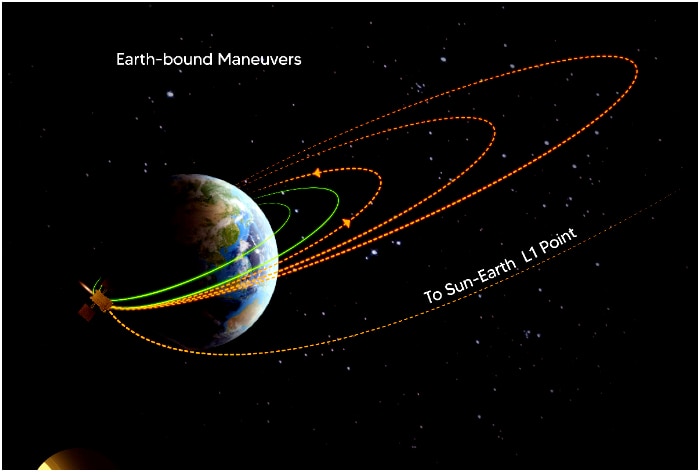The next maneuvre — third of the five Earth-bound manoeuvres scheduled — is scheduled for 2.30am on September 10.

New Delhi: In another piece of good news concerning India’s first solar mission, the Aditya-L1 spacecraft successfully executed its second Earth-bound maneuver. Providing details, the Indian Space Research Organisation stated early on Tuesday that ISTRAC/ISRO’s ground stations in Mauritius, Bengaluru, and Port Blair tracked the satellite during this operation. With this successful maneuver, the spacecraft has achieved a new orbit, which is now at 282 km x 40,225 km. The next maneuver (EBN#3) is scheduled for September 10th at approximately 02:30 Hrs (IST).
“The second Earth-bound maneuvre (EBN#2) is performed successfully from ISTRAC, Bengaluru. ISTRAC/ISRO’s ground stations at Mauritius, Bengaluru and Port Blair tracked the satellite during this operation. The new orbit attained is 282 km x 40225 km. The next maneuvre (EBN#3) is scheduled for September 10, 2023, around 02:30 Hrs. IST,” ISRO tweeted.
Aditya-L1 Mission:
The second Earth-bound maneuvre (EBN#2) is performed successfully from ISTRAC, Bengaluru.ISTRAC/ISRO’s ground stations at Mauritius, Bengaluru and Port Blair tracked the satellite during this operation.
The new orbit attained is 282 km x 40225 km.
The next… pic.twitter.com/GFdqlbNmWg
— ISRO (@isro) September 4, 2023
First Earth-Bound Maneuver
The Indian Space Research Organisation (ISRO) Sunday informed that India’s maiden solar mission – Adtya-L1 sucessfully performed the first Earth-bound maneuvre (EBN#1) on Sunday. It also stated that the spacecraft is in good health and operating as expected. “The first Earth-bound maneuvre (EBN#1) is performed successfully from ISTRAC, Bengaluru. The new orbit attained is 245km x 22459 km. The next maneuvre (EBN#2) is scheduled for September 5, 2023, around 03:00 Hrs. IST”, ISRO posted on X, formerly Twitter.
India’s Maiden Solar Mission
After making history with the landing of Chandrayaan-3 near the South pole of the moon, ISRO launched India’s first solar mission, Aditya-L1, from the Satish Dhawan Space Centre in Sriharikota on September 2. The satellite carries seven payloads that will conduct a detailed study of the sun. Out of these seven payloads, four will observe the light from the sun, while the other three will measure in-situ parameters of the plasma and magnetic fields.
Once it reaches its destination, which is 1.5 million km away from Earth, Aditya-L1 will be placed in a halo orbit around Lagrangian Point 1 (L1).
It is projected to complete the journey in four months. Aditya-L1 will orbit at a distance of approximately 1.5 million kilometres from Earth, facing the Sun, which is about 1 percent of the Earth-Sun distance. The Sun, a massive sphere of gas, will be the subject of study for Aditya-L1, particularly focusing on its outer atmosphere.
ISRO already cleared that Aditya-L1 will neither land on the sun nor approach the star any closer.
Lagrangian Points
Named after the Italian French mathematician Joseph-Louis Lagrange, there exist five Lagrange points between Earth and the Sun, where a small object remains stationary if placed there. At these points, the gravitational forces of Earth and the Sun balance the centripetal force required for a small object to move with them.
L1 Point
To reach the Lagrange L1 point, the spacecraft will be launched using onboard propulsion. This launch will allow it to escape Earth’s gravitational influence and proceed toward the L1 point. Subsequently, it will be inserted into a large Halo Orbit around the L1 point, which is close to the Sun. The Aditya-L1 Mission, ISRO stated, will take approximately four months from launch to reaching the L1 point.
The rationale behind studying the Sun, according to ISRO, is that it emits radiation across a broad spectrum of wavelengths, along with various energetic particles and magnetic fields. Earth’s atmosphere and its magnetic field serve as protective shields, blocking harmful radiation wavelengths. To detect such radiation, solar studies are conducted from space.
Primary Objectives
The primary objectives of the mission include understanding Coronal Heating and Solar Wind Acceleration, the initiation of Coronal Mass Ejections (CMEs), near-Earth space weather, and the distribution of the solar wind.
